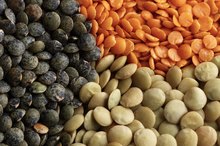5 Main Types of Healthy Food
When it comes to eating healthy, it seems everyone has advice. Eat meat, don't eat meat. Eat wheat, don't eat wheat. But healthy eating is not about who can follow the strictest diet or deprive themselves the most, it's about eating food that boosts your mood and energy, and gives your body the nutrients it needs to stay healthy. It's about eating the basics: fruits, vegetables, grains, protein foods and dairy.
Fruit for All
Fruits are low in calories and fat, and a good source of vitamins A and C, potassium, folate and fiber. Making fruit a regular part of your diet may lower your risk of heart disease, cancer, Type 2 diabetes and obesity. The U.S. Department of Agriculture's MyPlate says you need 2 cups of fruit a day on a 2,000-calorie diet 2. Include mostly whole fruits for the fiber, and vary your fruit choices throughout the week to vary your nutrient intake.
- Fruits are low in calories and fat, and a good source of vitamins A and C, potassium, folate and fiber.
- Making fruit a regular part of your diet may lower your risk of heart disease, cancer, Type 2 diabetes and obesity.
Vegetables: Rich In Nutrients
Weight Loss Diets for 15-Year-Olds
Learn More
Like fruit, vegetables are also low in calories and fat and rich in nutrients you need for good health. Eating vegetables also lowers your risk of chronic illness. As a low-calorie food, vegetables also help you keep a lid on calories, which may make it easier for you to achieve and maintain a healthier weight. On a 2,000-calorie diet you should have 2 1/2 cups of vegetables a day. To help you meet your daily fruit and vegetable needs, the USDA's MyPlate suggests you fill half your plate with fruits and vegetables.
- Like fruit, vegetables are also low in calories and fat and rich in nutrients you need for good health.
- As a low-calorie food, vegetables also help you keep a lid on calories, which may make it easier for you to achieve and maintain a healthier weight.
Make It Whole Grain
Grains include:
- any food made from rice
- wheat
- barley or other cereal,
- includes foods such as ready-to-eat cereal
- bread or pasta
For better health, at least half your grain choices should be whole grain. People who eat more whole grains have lower rates of heart disease and cancer, and have an easier time managing their weight. On a 2,000-calorie diet, you should get 6 ounces of grains a day, with at least half whole grain, where 1 ounce is equal to one slice of bread or 1/2 cup of cooked rice.
Protein Foods: Meat and Beans
Nutrition for Teen Girls
Learn More
In addition to meat and beans, protein foods also include eggs, soy products, nuts and seeds. To improve the nutritional quality of your diet, you should try to eat a variety of different sources of protein throughout the week, and make sure your meat choices are lean to limit your intake of saturated fat. Additionally, you should aim for two servings of seafood a week to increase the omega-3 fatty acids in your diet, which may help lower your risk of heart disease. On a 2,000-calorie diet, you can have 5 1/2 ounces of protein foods a day.
- In addition to meat and beans, protein foods also include eggs, soy products, nuts and seeds.
- Additionally, you should aim for two servings of seafood a week to increase the omega-3 fatty acids in your diet, which may help lower your risk of heart disease.
Dairy for Strong Bones
As a source of calcium and vitamin D, dairy foods are important for bone health. Dairy food choices include low-fat or fat-free milk, yogurt, cheese and calcium-fortified soy milk. Adults on a 2,000-calorie diet should aim for 3 cups of dairy foods a day, with one serving equivalent to 1 cup of milk, yogurt or soy milk, or 1 1/2 ounces of hard cheese.
Related Articles
References
- Helpguide.org: Healthy Eating: Easy Tips for Planning a Healthy Diet and Sticking to It
- U.S. Department of Agriculture: ChooseMyPlate.gov: Food Groups
- United States Department of Agriculture Center for Nutrition Policy and Promotion. Dietary Guidelines for Americans."
Writer Bio
Jill Corleone is a registered dietitian and health coach who has been writing and lecturing on diet and health for more than 15 years. Her work has been featured on the Huffington Post, Diabetes Self-Management and in the book "Noninvasive Mechanical Ventilation," edited by John R. Bach, M.D. Corleone holds a Bachelor of Science in nutrition.









